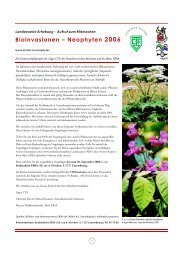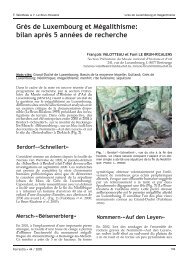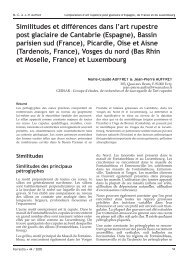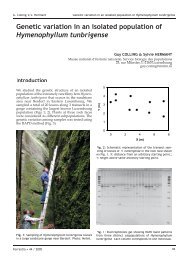The Hymenophyllaceae (Pteridophyta) in Luxembourg. Past ...
The Hymenophyllaceae (Pteridophyta) in Luxembourg. Past ...
The Hymenophyllaceae (Pteridophyta) in Luxembourg. Past ...
Create successful ePaper yourself
Turn your PDF publications into a flip-book with our unique Google optimized e-Paper software.
Y. Krippel <strong>The</strong> <strong>Hymenophyllaceae</strong> (<strong>Pteridophyta</strong>) <strong>in</strong> <strong>Luxembourg</strong>. <strong>Past</strong>, present and future<br />
<strong>The</strong> <strong>Hymenophyllaceae</strong> (<strong>Pteridophyta</strong>) <strong>in</strong><br />
<strong>Luxembourg</strong>. <strong>Past</strong>, present and future<br />
Ferrantia • 44 / 2005<br />
Yves KRIPPEL<br />
Research associate of the <strong>Luxembourg</strong> National Museum of Natural History<br />
18A, rue de Roll<strong>in</strong>gen, L-7475 Schoos<br />
yves.krippel@mnhn.lu<br />
Keywords: Hymenophyllum tunbrigense, Trichomanes speciosum, <strong>Luxembourg</strong>, Petite Suisse<br />
Introduction<br />
<strong>Luxembourg</strong>, and <strong>in</strong> particular the 'Petite Suisse'<br />
sandstone region, is one of the few cont<strong>in</strong>ental<br />
areas ever known for Hymenophyllum tunbrigense<br />
(L.) Smith, a species that generally occurs <strong>in</strong> a<br />
more Atlantic range (Jalas & Suom<strong>in</strong>en 1972). <strong>The</strong><br />
Tunbridge fi lmy-fern was fi rst discovered <strong>in</strong> this<br />
cont<strong>in</strong>ental island <strong>in</strong> 1823, but the location of the<br />
major colonies rema<strong>in</strong>ed uncerta<strong>in</strong> until the early<br />
20 th<br />
century follow<strong>in</strong>g its re-discovery <strong>in</strong> 1873.<br />
In 1993 the gametophytes of another fi lmy-fern,<br />
the Killarney fern (Trichomanes speciosum Willd.),<br />
were fi rst discovered for cont<strong>in</strong>ental Europe <strong>in</strong> the<br />
same region. Investigations showed however, that<br />
unlike Hymenophyllum tunbrigense, the gametophytes<br />
of Trichomanes speciosum are quite common<br />
<strong>in</strong> the 'Petite Suisse' area, as well as on Devonian<br />
schist <strong>in</strong> the <strong>Luxembourg</strong> Ardennes region.<br />
Tunbridge Filmy-fern<br />
(Hymenophyllum tunbrigense)<br />
History of its discovery<br />
Hymenophyllum tunbrigense (Fig. 1) was fi rst<br />
discovered <strong>in</strong> <strong>Luxembourg</strong> - and so with<strong>in</strong> cont<strong>in</strong>ental<br />
Europe - by the Belgium Botanist B.C. Du<br />
Mortier on a botanical trip with his friend P. Michel<br />
<strong>in</strong> 1823 [1821 as o en mentioned <strong>in</strong> literature is<br />
not correct (Reichl<strong>in</strong>g 2005)]. At that time however<br />
nobody seemed very impressed by the discovery<br />
of that Atlantic species <strong>in</strong> this cont<strong>in</strong>ental island.<br />
Half a century passed, and it was <strong>in</strong> 1873, that J.-<br />
P. J. Koltz rediscovered the plant near Berdorf <strong>in</strong><br />
the valley of the Roitzbach (Koltz 1873). A er the<br />
fi rst discoveries <strong>in</strong> <strong>Luxembourg</strong>, numerous <strong>in</strong>vestigations<br />
were made <strong>in</strong> the region and several<br />
Fig. 1: Patch of Hymenophyllum tunbrigense (Tunbridge<br />
Filmy-fern) with leaves <strong>in</strong> good condition, near Berdorf<br />
(<strong>Luxembourg</strong>). Photo: Y. Krippel.<br />
sites were found <strong>in</strong> the 'Petite Suisse', but the<br />
long-awaited discovery <strong>in</strong> the German part of the<br />
<strong>Luxembourg</strong> sandstone sandstone area was only only made made <strong>in</strong><br />
1963 (Nieschalk 1964). With<strong>in</strong> cont<strong>in</strong>ental Europe<br />
the Tunbridge Tunbridge Filmy-fern Filmy-fern was was also also found found <strong>in</strong> <strong>in</strong> the<br />
Elbsandste<strong>in</strong>gebirge (sites unfortunately ext<strong>in</strong>ct)<br />
and <strong>in</strong> the French Vosges (Jalas & Suom<strong>in</strong>en 1972).<br />
Nowadays the populations of Hymenophyllum<br />
tunbrigense have have seriously seriously suff suff ered and and many many sites<br />
sites<br />
are ext<strong>in</strong>ct ext<strong>in</strong>ct <strong>in</strong> <strong>in</strong> the the region, region, as as well well as as <strong>in</strong> <strong>in</strong> other other parts<br />
parts<br />
of Europe.<br />
Distribution and status<br />
<strong>The</strong> 'Petite Suisse' area <strong>in</strong> <strong>Luxembourg</strong> is one of<br />
the few cont<strong>in</strong>ental areas ever known for Hymenophyllum<br />
tunbrigense. Due to environmental<br />
changes and external pressures (specimen collec-<br />
tions, tourism and outdoor activities, …) a certa<strong>in</strong><br />
amount of sites have disappeared <strong>in</strong> the last<br />
decades (Fig. 2). Recent surveys have now shown<br />
a certa<strong>in</strong> population <strong>in</strong>crease.<br />
209
Y. Krippel <strong>The</strong> <strong>Hymenophyllaceae</strong> (<strong>Pteridophyta</strong>) <strong>in</strong> <strong>Luxembourg</strong>. <strong>Past</strong>, present and future<br />
210<br />
Fig. 2: Distribution map of Hymenophyllum tunbrigense (yellow squares: ext<strong>in</strong>ct sites, red squares: still exist<strong>in</strong>g<br />
sites). Grid: Gauss-<strong>Luxembourg</strong>, square kilometres.<br />
Ferrantia • 44 / 2005
Y. Krippel <strong>The</strong> <strong>Hymenophyllaceae</strong> (<strong>Pteridophyta</strong>) <strong>in</strong> <strong>Luxembourg</strong>. <strong>Past</strong>, present and future<br />
An <strong>in</strong>itial survey, realised <strong>in</strong> 1988, revealed the<br />
existence of 240 patches of fi lmy-fern which are<br />
sca ered amongst 27 sites. <strong>The</strong>ir distribution<br />
shows a cluster of 5 major rock complexes which<br />
are situated circa one kilometre apart. A total of<br />
20849 leaves cover<strong>in</strong>g a surface area estimated<br />
at 11.88 m 2 were identifi ed. Of these, only 40%<br />
were considered to be <strong>in</strong> good conditions and the<br />
majority of the population comprised either dead<br />
or dy<strong>in</strong>g leaves, with only one of the colonies<br />
conta<strong>in</strong><strong>in</strong>g a few fertile leaves. (Schwenn<strong>in</strong>ger<br />
1988).<br />
A new survey carried out <strong>in</strong> 2000 has shown that<br />
the number of fi lmy-fern patches has <strong>in</strong>creased to<br />
360 and the entire population now spreads over<br />
a surface area estimated at 12.38 m2 , consist<strong>in</strong>g of<br />
some 74700 leaves of which 74% are considered<br />
to be <strong>in</strong> good condition. Fertile leaves totalled 212<br />
and were encountered <strong>in</strong> most sites. For the fi rst<br />
time, fi lmy-fern gametophytes and young sporophytes<br />
were identifi ed, thereby confi rm<strong>in</strong>g that it is<br />
capable of reproduc<strong>in</strong>g both by vegetative spread<br />
and spores <strong>in</strong> its cont<strong>in</strong>ental refuge. (Schwenn<strong>in</strong>ger<br />
2001). Although the majority of sites generally<br />
refl ect this population <strong>in</strong>crease, the remarkable<br />
recovery is due largely to the contribution of the<br />
two sites from which the public has been excluded<br />
s<strong>in</strong>ce 1993. On a global level however, the number<br />
of sites is cont<strong>in</strong>u<strong>in</strong>g to dw<strong>in</strong>dle. Those sites<br />
where the fern was considered to be <strong>in</strong> danger of<br />
becom<strong>in</strong>g ext<strong>in</strong>ct <strong>in</strong> 1988 have now disappeared<br />
and the total number of <strong>in</strong>dividual sites which<br />
are physically separated from each other appears<br />
to have gradually decreased throughout the 20th are physically separated from each other appears<br />
th<br />
century.<br />
Prospects and conservation<br />
<strong>The</strong> collection of botanical specimens, undesirable<br />
silvicultural <strong>in</strong>terventions <strong>in</strong> the past, activities<br />
related to tourism as well as rock climb<strong>in</strong>g,<br />
represent the major threats for the Hymenophyllum<br />
sites. Not surpris<strong>in</strong>g that the drastic measures<br />
to remove the massive human presence at some<br />
sites - by se <strong>in</strong>g up gates <strong>in</strong> 1993 - have well<br />
contributed to the expansion of some populations.<br />
It is however possible that overall climatic conditions<br />
may have been particularly benefi cial to the<br />
growth rates of the fi lmy-fern colonies <strong>in</strong> recent<br />
years, perhaps as a consequence of global warm<strong>in</strong>g<br />
or that we may be deal<strong>in</strong>g with long-term fl uctuations<br />
<strong>in</strong> population cycles.<br />
Besides the mentioned gates, some other m<strong>in</strong>or<br />
measures and a new set of local bylaws govern<strong>in</strong>g<br />
the legal conditions under which rock climb<strong>in</strong>g<br />
is permi ed were carried out. But a empts to<br />
enhance the legal protection of fi lmy-fern sites<br />
and boost conservation <strong>in</strong>itiatives <strong>in</strong> the area by<br />
offi cially designat<strong>in</strong>g the entire forest as a national<br />
nature reserve failed so far.<br />
Ferrantia • 44 / 2005<br />
Killarney Fern<br />
(Trichomanes speciosum)<br />
History of its discovery<br />
Although primarily a species of the UK, Ireland,<br />
Bri any and the Atlantic Islands (Canaries,<br />
Madeira and Azores), the fi lmy-fern Trichomanes<br />
speciosum (Killarney fern) is also found <strong>in</strong> Europe<br />
at sca ered locations <strong>in</strong> other parts of France,<br />
Spa<strong>in</strong>, Portugal and Italy (Jalas & Suom<strong>in</strong>en 1972).<br />
<strong>The</strong> gametophytic generation of Trichomanes<br />
speciosum can however be found <strong>in</strong>dependently<br />
of the sporophyte and seems to be widespread<br />
<strong>in</strong> Europe, <strong>in</strong> contrast to the sporophyte (Rumsey<br />
et al. 1999). It appears however to exist <strong>in</strong> a state<br />
of arrested development, unable to produce the<br />
mature form under present conditions. In <strong>Luxembourg</strong><br />
the <strong>in</strong>dependent gametophyte of Trichomanes<br />
speciosum was fi rst discovered <strong>in</strong> 1993 (Jermy<br />
pers. comm., Rasbach, Rasbach & Jérôme 1993).<br />
And aga<strong>in</strong> this was the fi rst observation of this -<br />
even more Atlantic - species <strong>in</strong>side the cont<strong>in</strong>ent!<br />
A er the fi rst discoveries <strong>in</strong> the "Petite Suisse" <strong>in</strong><br />
<strong>Luxembourg</strong>, the gametophytes of T. speciosum<br />
were found <strong>in</strong> many places on the cont<strong>in</strong>ent<br />
(France, Germany, Belgium, Czech Republic and<br />
more recently <strong>in</strong> Poland (Krukowski & Świerkosz<br />
2004)). In <strong>Luxembourg</strong>, systematic <strong>in</strong>vestigations<br />
revealed a great number of populations, not only<br />
<strong>in</strong> the <strong>Luxembourg</strong> Sandstone region, but also on<br />
Devonian Schist <strong>in</strong> the Ardennes region (Krippel<br />
2001).<br />
Fig. 3: Gametophytes of Trichomanes speciosum (Killarney<br />
fern) on <strong>Luxembourg</strong> sandstone. Photo: Y. Krippel.<br />
211
Y. Krippel <strong>The</strong> <strong>Hymenophyllaceae</strong> (<strong>Pteridophyta</strong>) <strong>in</strong> <strong>Luxembourg</strong>. <strong>Past</strong>, present and future<br />
212<br />
Fig. 4: Distribution map of Trichomanes speciosum. Grid: Gauss-<strong>Luxembourg</strong>, square kilometres.<br />
Ferrantia • 44 / 2005
Y. Krippel <strong>The</strong> <strong>Hymenophyllaceae</strong> (<strong>Pteridophyta</strong>) <strong>in</strong> <strong>Luxembourg</strong>. <strong>Past</strong>, present and future<br />
Distribution and status<br />
Trichomanes speciosum is grow<strong>in</strong>g <strong>in</strong> <strong>Luxembourg</strong><br />
as an '<strong>in</strong>dependent gametophyte' with vegetative<br />
reproduction and dispersion by the way of<br />
gemmae (Fig. 3). Diff erent studies and systematic<br />
<strong>in</strong>vestigations over the last 5 years showed that<br />
the gametophytes of Trichomanes speciosum are<br />
relatively well distributed throughout the 'Petite<br />
Suisse' sandstone area with nevertheless 2 major<br />
distribution spots. <strong>The</strong> fi rst one is situated on<br />
both sides of the 'Ernz noire' between Echternach,<br />
Berdorf, Beaufort, Waldbillig, Christnach and<br />
Consdorf, the second one between the 'Ernz<br />
blanche' and the Valley of the Alze e. A third<br />
major distribution area is situated <strong>in</strong> the Ardennes<br />
region, especially <strong>in</strong> the valley of the Upper-Sûre.<br />
At present date, more than 120 sites are known <strong>in</strong><br />
80 diff erent square kilometres (Fig. 4). Even if the<br />
species is quite widespread <strong>in</strong> <strong>Luxembourg</strong>, the<br />
populations occurr<strong>in</strong>g <strong>in</strong> the 'Petite Suisse' are the<br />
most luxuriant ones. <strong>The</strong> status of the <strong>in</strong>dependent<br />
Trichomanes speciosum gametophyte populations<br />
<strong>in</strong> <strong>Luxembourg</strong> is - as far as no major site alterations,<br />
result<strong>in</strong>g <strong>in</strong> drastic climatic changes, occur<br />
- considered as not threatened.<br />
Conclusion<br />
<strong>Luxembourg</strong>, and <strong>in</strong> particular the 'Petite Suisse'<br />
sandstone area, is one of the few regions <strong>in</strong> cont<strong>in</strong>ental<br />
Europe where two species of the <strong>Hymenophyllaceae</strong><br />
family occur. Hymenophyllum tunbrigense<br />
is - no doubt about that - the greatest treasure.<br />
Despite the recent <strong>in</strong>crease <strong>in</strong> the overall Hymenophyllum<br />
population and the apparent success<br />
at secur<strong>in</strong>g the protection of the most 'valuable'<br />
sites, the further loss of small sites is regre able.<br />
<strong>The</strong> survival of the species isn't guaranteed, as the<br />
most important group of sites are all restricted<br />
to a s<strong>in</strong>gle crevasse, currently hold<strong>in</strong>g 74% of<br />
the overall population. A global conservation<br />
management plan, <strong>in</strong>tegrat<strong>in</strong>g the recent microclimatic<br />
and genetic studies is therefore imperative <strong>in</strong><br />
order to ma<strong>in</strong>ta<strong>in</strong> the species. Concern<strong>in</strong>g Trichomanes<br />
speciosum, only the gametophytic stage is to<br />
be found <strong>in</strong> <strong>Luxembourg</strong>. <strong>The</strong> gametophytes are<br />
quite widespread <strong>in</strong> <strong>Luxembourg</strong> and the species<br />
is considered as not threatened. However, pteridologists<br />
don't give up, and perhaps one day the<br />
sporophytic generation will also be found <strong>in</strong> the<br />
region.<br />
Ferrantia • 44 / 2005<br />
References<br />
Jalas J. & Suom<strong>in</strong>en J. (eds.) 1972. - Atlas Florae<br />
Europae. Distribution of vascular plants <strong>in</strong><br />
Europe. Vol.1: <strong>Pteridophyta</strong> (Psilotaceae to<br />
Azollaceae). - <strong>The</strong> Commitee for Mapp<strong>in</strong>g the<br />
Flora of Europe and Societas Biologica Fennica<br />
Venamo, Hels<strong>in</strong>ki, 121 p.<br />
Koltz J.-P. J. 1873. - Hymenophyllum tunbridgense<br />
Sm. - Bull. Soc. roy. Bot. Belg. XII : 449-453.<br />
Krippel Y. 2001. - Aire de répartition et statut de<br />
Trichomanes speciosum Willd. (<strong>Hymenophyllaceae</strong>)<br />
au Grand-Duché de <strong>Luxembourg</strong>. -<br />
Bull. Soc. Nat. luxemb. 102: 3-13.<br />
Krukowski M. & Świerkosz K. 2004. - Discovery<br />
of the gametophytes of Trichomanes speciosum<br />
(<strong>Hymenophyllaceae</strong>: <strong>Pteridophyta</strong>) <strong>in</strong> Poland<br />
and its biogeographical importance. Fern Gaz.<br />
17(2): 79-84.<br />
Nieschalk A. et C., 1964. - Hymenophyllum<br />
tunbrigense (L.) Sm. (Englischer Hautfarn) im<br />
westlichen Deutschland. - Decheniana 117, 1/2:<br />
151-152. 2 pl h.t.<br />
Rasbach H., Rasbach K. & Jérôme C. 1993. - Über<br />
das Vorkommen des Hautfarns Trichomanes<br />
speciosum (<strong>Hymenophyllaceae</strong>) <strong>in</strong> den Vogesen<br />
(Frankreich) und dem benachbarten Deutschland.<br />
Carol<strong>in</strong>ea 51: 51-52.<br />
Reichl<strong>in</strong>g L. (coll. Y. Krippel) 2005. - Die Farnpfl<br />
anzen (<strong>Pteridophyta</strong>) des Müllerthalgebietes.<br />
- In: Y. Krippel (ed.). - Die Kle<strong>in</strong>e Luxemburger<br />
Schweiz. Geheimnisvolle Felsenlandscha im<br />
Wandel der Zeit, 251 p.<br />
Rumsey F.J., Vogel J.C., Russel S.J., Barret J.A. &<br />
Gibby M. 1999. - Population structure and<br />
conservation biology of the endangered fern<br />
Trichomanes speciosum Willd. (<strong>Hymenophyllaceae</strong>)<br />
at its northern distributional limit.<br />
- Biological Journal of the L<strong>in</strong>nean Society 66:<br />
333-344.<br />
Schwenn<strong>in</strong>ger J.-L. 1988. - Hymenophyllum<br />
tunbrigense (L.) Sm. - Rapport dӎtude sur<br />
l”écologie et la conservation de l”espèce. -<br />
M<strong>in</strong>istère de l”Environnement. Adm<strong>in</strong>istration<br />
des Eaux et Forêts,107 p. (unpublished).<br />
Schwenn<strong>in</strong>ger J.-L. 2001. Inventaire phytosanitaire<br />
et conservation des populations relictuelles<br />
de Hymenophyllum tunbrigense (L.)<br />
Smith (<strong>Hymenophyllaceae</strong> : <strong>Pteridophyta</strong>) au<br />
Grand-Duché de <strong>Luxembourg</strong>. - M<strong>in</strong>istère de<br />
l’Environnement, Adm<strong>in</strong>istration des Eaux et<br />
Forêts,153 p. (unpublished).<br />
213
Y. Krippel <strong>The</strong> <strong>Hymenophyllaceae</strong> (<strong>Pteridophyta</strong>) <strong>in</strong> <strong>Luxembourg</strong>. <strong>Past</strong>, present and future<br />
Résumé de la présentation<br />
Les <strong>Hymenophyllaceae</strong> (<strong>Pteridophyta</strong>) au <strong>Luxembourg</strong>. Passé, présent et futur<br />
214<br />
Mots-clés: Hymenophyllum tunbrigense; Trichomanes speciosum; <strong>Luxembourg</strong>; Petite Suisse<br />
Le Grand-Duché de <strong>Luxembourg</strong> et en particulier la<br />
région gréseuse de la Petite-Suisse luxembourgeoise<br />
sont une des rares régions cont<strong>in</strong>entales renommées<br />
pour leurs populations rélictuelles d'Hyménophylle de<br />
Tunbridge (Hymenophyllum tunbrigense), espèce qui en<br />
général pousse dans des zones à caractère plus atlantique.<br />
Hymenophyllum tunbrigense fut découvert pour la<br />
première fois dans ce refuge cont<strong>in</strong>ental en 1823, mais<br />
la localisation de la majeure partie des colonies restait<br />
<strong>in</strong>certa<strong>in</strong>e jusqu'au début du 20 ième siècle, suite à la<br />
redécouverte de l'espèce en 1873. En 1993, les gamétophytes<br />
d'une autre fougère de la famille des Hyménophyllacées,<br />
à savoir Trichomanes speciosum Willd. ont été<br />
découverts pour la première fois en Europe cont<strong>in</strong>entale<br />
dans la même région. Des <strong>in</strong>vestigations ont cependant<br />
montré que contrairement à Hymenophyllum tunbrigense,<br />
les gamétophytes de Trichomanes speciosum sont<br />
assez communs dans la Petite Suisse luxembourgeoise,<br />
de même que sur les schistes dévoniens en Ardennes<br />
luxembourgeoises.<br />
En ce qui concerne le statut d'Hymenophyllum tunbrigense<br />
au <strong>Luxembourg</strong>, un certa<strong>in</strong> nombre de sites ont malheu-<br />
reusement disparus au cours des dernières décennies,<br />
suite à des changement environnementaux ou des<br />
pressions externes (tourisme, escalade, …). D'un autre<br />
côté, des études récentes ont montré une ne e augmentation<br />
de la taille des populations, ceci particulièrement<br />
à cause de deux sites, dont l'accès du public a été <strong>in</strong>terdit<br />
depuis 1993. La survie d'Hymenophyllum tunbrigense<br />
n'est toutefois pas garantie, car les plus belles stations<br />
- comprenant 74% de la totalité des populations - sont<br />
restre<strong>in</strong>tes à une seule crevasse. Un plan de gestion et de<br />
conservation global, <strong>in</strong>tégrant les récentes études microclimatiques<br />
et génétiques est donc impératif, en vue de<br />
ma<strong>in</strong>tenir l'espèce.<br />
En ce qui concerne Trichomanes speciosum, seul le stade<br />
gamétophytique est connu au <strong>Luxembourg</strong>. Actuellement<br />
plus de 120 sites sont connus dans 80 kilomètres carrés<br />
diff érents. Même si l'espèce est assez bien répandue au<br />
<strong>Luxembourg</strong>, les populations les plus luxuriantes sont<br />
cependant trouvées dans la région gréseuse de la Petite<br />
Suisse. Hormis des aménagements majeurs entraînant<br />
des changements climatiques drastiques, l'espèce peut<br />
être considérée comme non menacée au <strong>Luxembourg</strong>.<br />
Ferrantia • 44 / 2005








